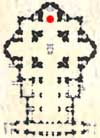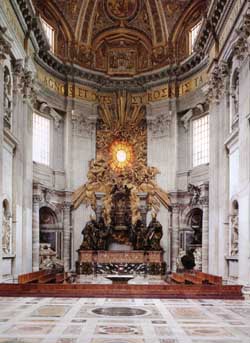| Grottoes
Vatican City Colonnade Saints Floorplan #2 |
| Altars
Monuments The History |
| Related
Items Cathedra Petri |
|
The Main Tribune (or apse) holds the Cathedra Petri (St Peter's Throne), with the Monument to Paul III (left) and Urban VIII (right). Above, on the golden background of the frieze, is the Latin inscription: "O Pastor Ecclesiae, tu omnes Christi pascis agnos et oves" (O pastor of the Church, you feed all Christ's lambs and sheep). On the right is the same writing in Greek. |
From:
'St. Peter's - Guide to the Basilica and Square '
The apse is at the end of the central nave. In the center is the Altar
of the Chair of Peter, a masterpiece which is unmistakably the work of
Gian Lorenzo Bernini (1598-1659).
Every year on February
22, the Church celebrates the feast of the Chair of St. Peter, to commemorate
St. Peter's teaching in Rome. Already in the second half of the 18th century
an ancient wooden chair inlaid with ivory was venerated and traditionally
held to be the Episcopal chair on which St. Peter sat as he instructed
the faithful of Rome. In fact, it is a throne in which fragments of acacia
wood are visible, which could be part of the chair of St. Peter, encased
in oak and reinforced with iron bands. Several rings facilitated its transportation
during processions. Pope Alexander VII commissioned Bernini to build a
sumptuous monument which would give prominence to this ancient wooden
chair. Bernini built a throne in gilded bronze, richly ornamented with
bas-reliefs in which the chair was enclosed: two pieces of furniture,
one within the other. On January 17, 1666 it was solemnly set above the
altar.
From:
'St. Peter's Basilica - A Virtual Tour' by Our
Sunday Visitor
Continuing on we reach the main tribune, which is the same size as the
two arms of the transept, but appears larger and more majestic since it
seems to be the prolongation of the nave.
Climbing the two porphyry steps which mark the entrance to it, we continue under the spacious vault, decorated with gilded stucco on a white background designed by Luigi Vanvitelli. Above the altar are three round panels containing bas-reliefs sculpted by Maini, the one in the center representing the Redeemer handing over the keys to Peter from Raphael's tapestry, the ones at the sides showing Peter's Crucifixion from the painting by Reni, and the Decollation of St. Paul from a silver relief by Algardi.
Among the statues of the Founders placed here, those from the 18th century deserve mention: St. Benedict by Montauti, St. Elias by Cornacchini, St. Francis of Assisi by Monaldi and St. Dominic by Legros, all from the first half of the century.
At the end of the apse, in the center, is St. Peter's Chair, perfectly visible through Bernini's Canopy even from the entrance. It is a large bronze structure containing the ancient oak Throne decorated with small carved ivory plaques showing the labors of Heracles and some celestial constellations.
From:
'THE NEW SAINT PETER'S'
The luminous design of Michelangelo for the apse was overpowered by the
formidable decorative sense of Bernini, with the later addition of Vanvitelli's
gilded stucco, moulded by Maini. Bernini's ingenious creation glorifies
the Cathedra which tradition once held had been used by Saint Peter.


